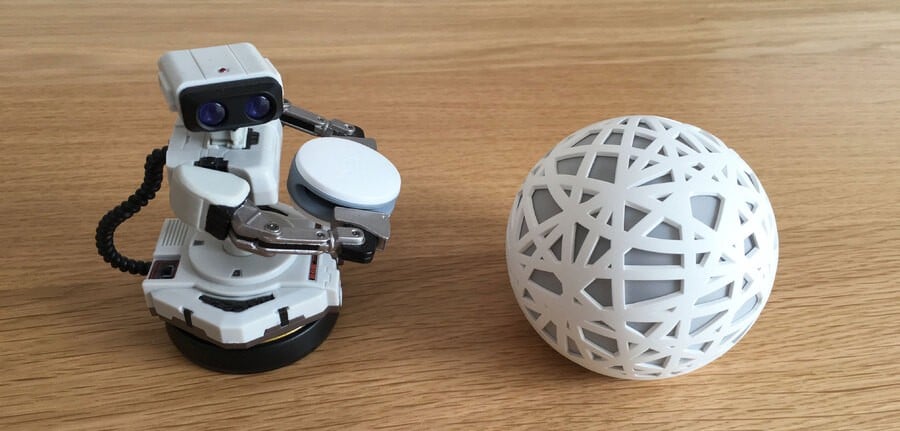
Getting a good night's sleep plays a vital role in your well-being, so it's easy to see why Nintendo plans to tackle this first and foremost in the Quality of Life (QOL) initiative which was set into motion by the late Satoru Iwata. While Nintendo's sleep tracking gizmo was thought to be on hold indefinitely based on comments made to investors earlier in the year, it seems to be very much back on the agenda based on a statement found in the 2016 annual report:
Moreover, Nintendo is working on the development of a new product that improves people's QOL (Quality of Life) in enjoyable ways. Nintendo's aim is to enable consumers to make daily efforts to improve their QOL in a fun manner by making sleep and fatigue status visible and offering various services based on this information.
As shown in the diagram released by Nintendo some time ago, its original QOL device concept is designed to visualise sleep and fatigue using five non-sensing automatic measurements:
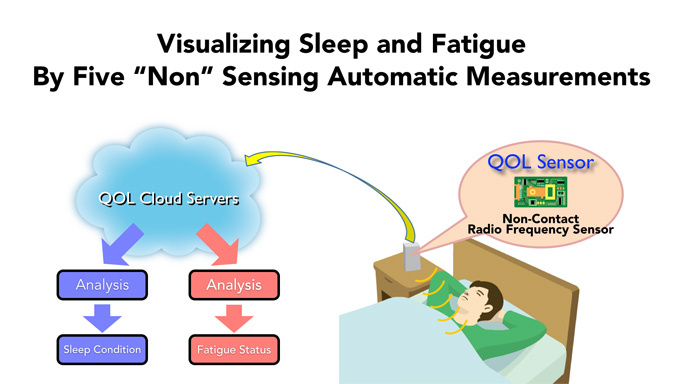
Of course there are already lots of fitness bands on the market that can track how long you sleep, and in addition to this there are a number of non-wearable sleep monitors out there too. Curious to know what these devices are currently capable of we tried out a Hello Sense sleep monitor that was provided to us, to see if it could give us any clues as to what form Nintendo's upcoming QOL device might take. The Hello Sense Kickstarter was a success back in 2014 and just under 20,000 backers pledged over $2,400,000 to help realise this device; it's now out on the market, and can be bought from the likes of Amazon US and Amazon UK. Perhaps Nintendo is onto something with this concept, and the only problem with its approach to QOL so far is taking so long to bring it to market?
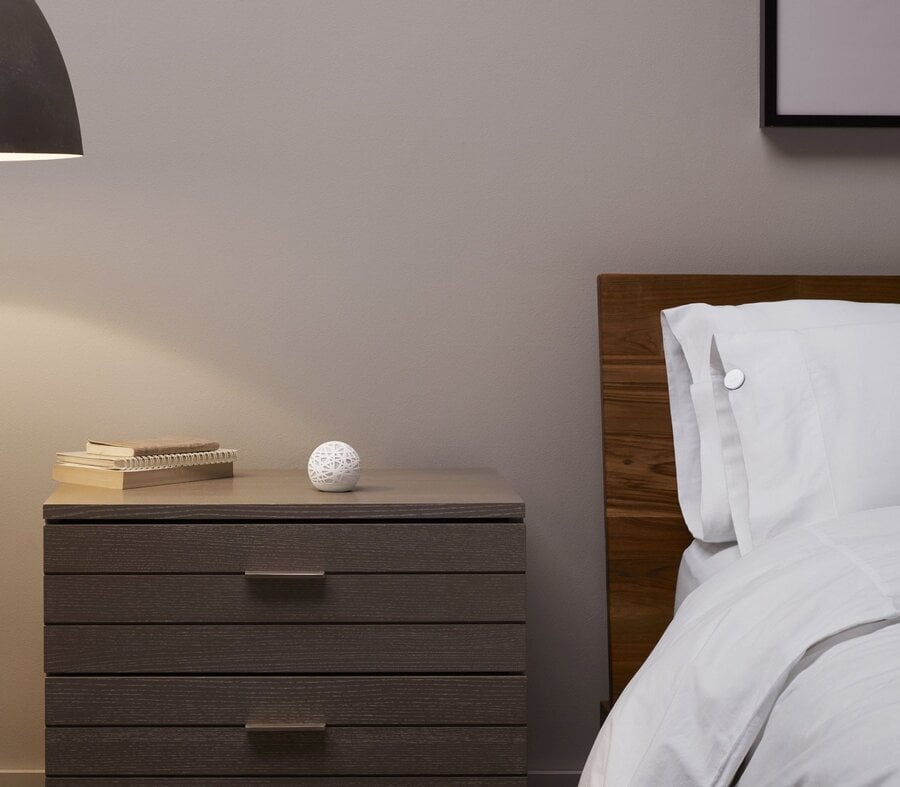
The Hello Sense sleep monitor is a neat sci-fi looking orb which sits inconspicuously on your nightstand, in addition to this you get a 'Sleep Pill' which is clipped onto the edge of your pillow, which actually monitors your movement during the night. A second Sleep Pill can be used for a partner's pillow.
Aside from simply monitoring how long you spend in bed and how much you move, the Hello Sense can also measure and advise when the following areas might be adversely affecting the quality of your sleep: temperature, humidity, air quality, brightness and noise level. As it's the Summer here in the UK at the moment my bedroom was a little too warm, so opening a window helped with that. My room was often slightly too humid too, so running a dehumidifier for 30 minutes before bed helped clear that up. Thankfully the air quality was good, though those in cities may have little control over that!
Unlike wearables that require frequent charging, one of the nice things about the Hello Sense is that it just works. No buttons to press when you get ready to go to sleep or wake up, the device is happy to fade into the background and do its job without any user input beyond the initial setup; this is very much in line with the non-wearable concept that Nintendo has highlighted in the past.
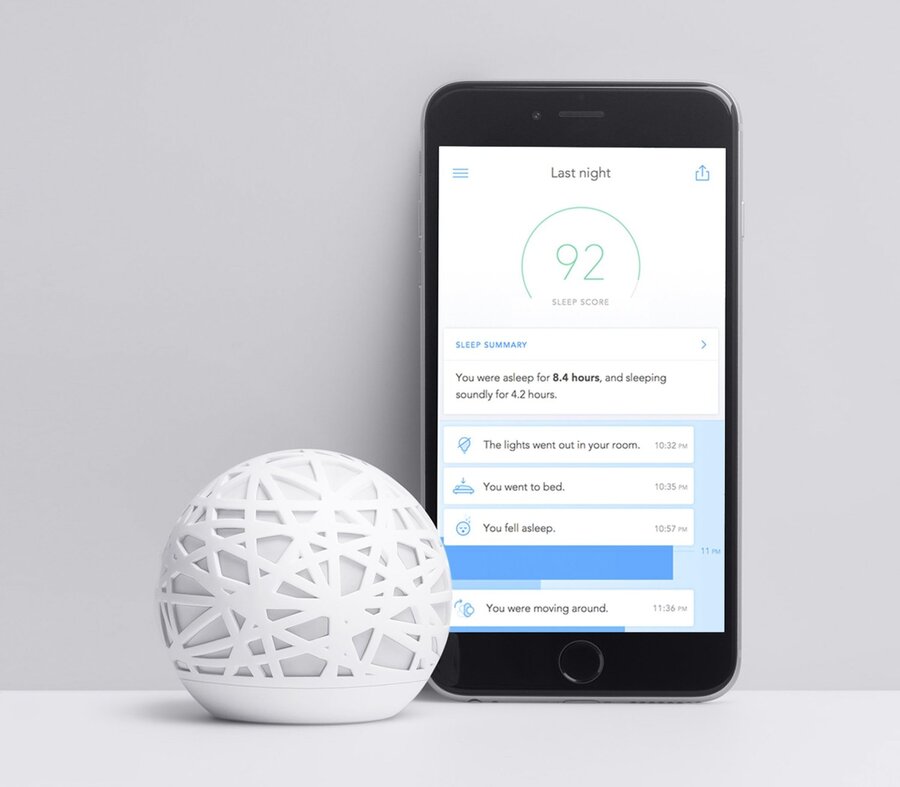
Another neat feature allows you to choose from a range of calming ambient sounds to play for a short time, which can help you fall asleep and stay slumbering through the night. Also, by monitoring your sleep cycle, Sense's Smart Alarm identifies the best time for you to wake up each morning.
When you wake up in the morning you can check the companion app on iOS and Android which gives you a personalised Sleep Score (out of 100) based on the conditions of your bedroom, and how well you slept the night before. While this is just a simple thing, it does encourage you to make adjustments to your bedroom environment and sleep habits, get better sleep, and raise your Sleep Score.
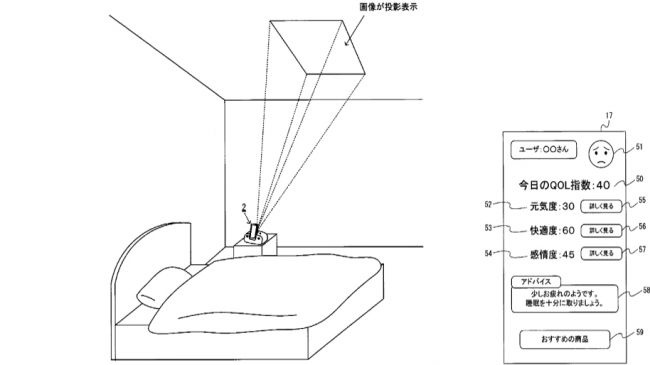
So how might Nintendo be able to improve on existing devices on the market - such as Hello Sense - which already do a solid job of monitoring sleep quality and encouraging change to improve this over time? Let's consider some blurb from Nintendo's QOL patent application which surfaced in July last year.
This display system is provided with a sensor, a projector and a control means. The sensor detects user information for calculating a state relating to sleep of a user. The user information is, for instance, biological information, such as pulse rate. The projector displays, by means of projection, a predetermined image. For instance, the projector displays, by means of projection, an image on a ceiling by projecting the image upward. The control means controls the projector corresponding to the sleep-related state calculated on the basis of the user information.
Monitoring heart rate would give Nintendo's sleep monitor a clear advantage over competitors. We've seen reports that aspects of Nintendo NX could be utilising Pixart Imaging's heart rate sensor recently, so this would definitely seem to be on the cards still. While an accelerometer which is used in Hello Sense's Sleep Pill can in theory tell when a person is awake versus asleep, technology like this can be prone to mistakes. By monitoring a heart rate the user would get a much more accurate understanding of the quality of their sleep. If this can be done remotely rather than having to wear a chest strap or wrist optical heart rate monitor, this would be all the better.
Would a projector improve the experience at all? The jury is still out on this, as it would only be visible when the room is dark it's questionable what use this would be; like a lot of patent concepts, this could be well off the mark in terms of a final product. You'd probably tap the device to get a projection of the environment in your room rather than firing up an app to see this. If you wave your hand over the Hello Sense, it will glow green if the room conditions are good, amber if something minor isn't ideal, or red if something is really wrong. But ultimately you have to fire up the app to get the actual details of what needs to be improved for a good night's sleep.
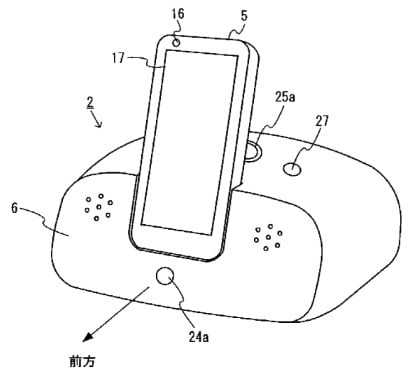
One of the other diagrams in Nintendo's patent shows a Wii Balance Board by the bed. Of course there is more to quality sleep than just environmental factors; being overweight can affect sleep. Some patent diagrams have also shown a smart device / tablet in a docking station; if reports on the NX having this sort of form factor are accurate as seems likely, there's possible cross-over.
Could Nintendo go beyond this and also use an app similar to Miitomo to question the user on their habits? How much have you exercised this week? How much caffeine have you consumed? Have you considered changes to your diet? If Nintendo can find a way to present this information to users in a way that is accessible and relaxing it could be really useful.
Of course the most obvious thing Nintendo could improve on with its Sleep Monitor is factoring gamification into the experience. As a video game company, Nintendo has the expertise to produce apps and interactions that can be entertaining, relaxing, or a mix of various qualities. This would tap into the basic desires and needs of the user's impulses, which revolve around the idea of status and achievement. Hello Sense's nightly sleep score out of 100 gives a target to be improved upon, but Nintendo might possibly be able to take this to the next level.
The area of QOL could be a notable opportunity for Nintendo if it can create compelling devices that people crave. Hello Sense's Kickstarter had 20,000 backers who collectively pledged over $2,400,000 to bring the device to life, so there is definitely a huge demand for systems like this. The question is whether Nintendo can successfully tap into the market.
Please note that some external links on this page are affiliate links, which means if you click them and make a purchase we may receive a small percentage of the sale. Please read our FTC Disclosure for more information.
Comments 47
I'll pass on this I think.
No. Just no.
Make games Nintendo, not fancy gadgets.
Must fight urge to write off whole concept before reading details.......
See, this is what we get when we complain about too many Pokemon Go and NX articles, N Life punishes us with this.
@Elanczewski why can't they do both?
I could really use something like this, to be honest. QoL is looking more and more feasible the more we learn about it.
"I'll pass on this I think."
"No. Just no."
"Make games Nintendo, not fancy gadgets."
That's exactly what I meant several months ago (in a discussion here) with too many being against innovation, afraid of or not open to trying new things etc.
Why are so-called Nintendo fans against innovation when innovation is what makes Nintendo special?
I already knew Hello Sense and would've bought it via Kickstarter if it weren't so expensive. I'm absolutely supporting Nintendo if they want to build something like this. But the problem is: they should be quick about it, because others are already doing it and Nintendo would be late to the party.
Sleep has never been an issue for me thankfully. I close my eyes,I conk out and wake up in the same position 6 to 8 hours later.My mum on the other hand is the complete opposite, she's always had problems getting a decent sleep.This would make a good Xmas present for her.
If Nintendo insisted on exploring Quality of Life opportunities, I think they would be better off partnering with someone already in the market. Sleep monitoring doesn't really interest me.
I would be interested in maybe partnering with Fitbit on the Wii Fit NX. I still use my Wii Fit pedometer. I hope to finish the Tour of Italy before the end of the year.
@fortius54 honestly Pokemon go should have partnered with fit bit instead of using that little blue tooth thingy.
As someone who suffers from sleep apnea, I'm intrigued to see what Nintendo has to offer here. Not being able to get sound sleep really sucks.
@fortius54 yes! I want a fitbit but this will win me over. Make it happen Nintendo!
Hmm, this could be interesting to see, even though it's apparently not exactly something all gamers must love to read about
I'm all for Nintendo trying to fix dysfunctional lives. Especially since I go to sleep in the AM hours, which is unacceptable for a growing body. Not only that, other people do too, which is also bad and has to be fixed.
..."No. Just no.", "Make games Nintendo, not fancy gadgets.", I'll pass on this I think."...
...Stupid people. Not being open to newfound health is something that is utterly pitiable.
This better have online. Imagine being able to complete in tournaments, who can sleep better?
Less than Zero interest in this.
@faint Because some gamers are insecure and think this will mean the end of hardcore triple-A video games. See also: resentment towards casuals, gamergate, hatred of mobile/motion gaming, etc.
@ShadJV As crazy as that sounds, competitive sleeping might be the motivation some people need to get a good night's sleep (possibly including me).
@3MonthBeef You know, sleep requirements aren't the same for everyone. See Sleep Number.
Personally, I can't wait to see how this turns out. The talk of Ninty partnering with ResMed, however, sounds like it may not be cheap.
@3MonthBeef "noise level: a neighboring jerk making too much noise"
Or that could also be: a neigbor jerking off and making too much noise...
But seriously: it's not as black and white as you say it is.
Some people have had a life long experience in getting used to certain conditions to life and sleep in, but that doesn't mean that they couldn't improve upon them. And there's a lot of variables in between that aren't always as immediately noticeable like in the examples you gave.
For example: let's say you went to bed on time, fell asleep pretty quickly, yet when you wake up the next morning, you still feel tired and not at all ready to face the day.
Other than tired, you aren't sweaty, your throat isn't dry nor are there any other effects noticeable to you. What the hell is going on?
A sleep monitor could register that, and would probably be able to give you data to explain to you that something happened to you in between REM and deep sleep that made it so that you actually didn't get a good night's rest, even though you went to bed on time.
And that's just one example, so I wouldn't go saying that most people in the world don't need a device to tell them this sort of stuff just yet. Next thing you know we are also going to be our own doctor, because we obviously all know when we are feeling bad...
I don't understand all the hate on this. Nintendo needs to diversify and release things that can cross-pollinate. Even Sony and Microsoft are struggling to come to terms with how fast tech and people's habits with that tech are changing. I think Nintendo is going the Apple route and release devices with a shared OS and combinability. That might be the smartest move they can make at this juncture.
If it arranges for R.O.B. to bring me a cup of tea in the morning when I wake up then I'm buying it.
What I like about Nintendo is how they make something simple or serious and make it fun and charming. I wonder how they will approach this.
I sleep poorly partly because I end up on my 3ds in bed for too long.
Nintendo's fault, obviously.
Better than this night light, that's for sure.

@3MonthBeef The doctor thing was just a bit of leg pulling, obviously. No harm intended. And I know health care sucks in the US. Over here it is much better, not so much a business, but there are still questionable goings on, probably much like in any other country you could think of. It's more of a "lesser evil" kind of thing.
Meant no offense with the example either. Thought that you were talking in general, and naming all the things you could come up with, but having re-read the article with your points in mind, I see where you got them from. Anyways, you could still say that my response was somewhat fitting to your final conclusion: maybe this device isn't for you, but there is definitely a market for such devices and services, as the example in the article clearly demonstrates with the successful kickstarter of the Hello Sleep device.
@AlexSora89 I must have that.
I thought the sleep sensor was dead? I thought the new pres basically confirmed it. There may be other health monitors/sensors coming but I don't see this coming at all.
@3MonthBeef you mentioned MyPillow. Do you (or anyone else here) have one of those? I hear endorsements and spots (commercials) on the radio promoting MyPillow and it's effectiveness. They are a bit pricey...and was just curious if anyone has used one.
Some people are really afraid of innovation. Just because NX will have an unique feature like that, it doesn't mean ruins the gameplay quality. One thing, hardcore AAA games is NOT everything, nor even the GOD of the games. Great games NOT always have to be hardcore or sadistic with gory violence. Even cute games like on 3DS or NDS can oversold hardcore AAA games. Some gamers must change their mindset.
Guys if they develop this then we will be 1 step away from playing legend of Zelda in our dreams. Imagine paying $60 to have a dream about Zelda. I can only imagine the copywrite issues for people who dream about zelda without paying. Ah the future
there's also the idea of the electroshock alarm clock that electrocutes you until you are suitably awake enough to shut it down, or of course die. the choice is yours.
@Jamotello
Wow...creepy....
I wonder what constitutes 'good sleep'. I mean, I sleep 5-6 hours per night and feel great the next day, whereas my girlfriend feels tired after 10 hours. I'm guessing there's an ideal quantity of sleep, but this is presumably aggregated across many thousands of study subjects, and wouldn't account for individual needs.
I'm thinking the base there with the smartphone will actually be a NX controller,
Almost like the SEGA Dreamcast's VMUs, just bigger and 2 can connect to either side of the NX, notice they will both have displays/touchsreens, XYAB and WiiU control stick on each.
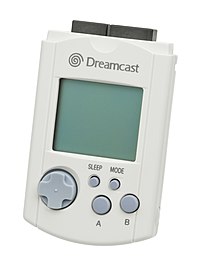
@MagicEmperor
Actually I was looking for a night light shaped like some horror character, a picture I stumbled across when browsing Tv Tropes a few years ago. But given I can't remember what the character was, I went with the first scary night light I found.
So if you buy into this concept you are innovative and brave. If you aren't interested you are fearful and stupid. A lot to glean from short posts.
Wow. Still, good to see the judgmental attitude amongst posters here is alive and well. Do keep up the good work.
"Enough sleep! Go play Nintendo!!!"
@k8sMum Eh, if you aren't interested, why bother commenting "not interested"? Why not save energy, and just keep scrolling? I'll never understand that mentality, the need to groan.
@AlexSora89 Haha! That's right up my alley. Years ago when I was alone in an apartment, I had a horror movie poster above my bed. I had the knife on said poster angled juuuuust perfectly toward my face.
@onex
Yet here you are groaning about other's need to groan. Lol.
@k8sMum I recognize that.
Although, you can't really classify it as groaning when someone is expressing confusion. So, double
@MagicEmperor

You have an... interesting way to fall asleep.
@AlexSora89 Just like Mama taught me. <3
@MagicEmperor
Your mom got you into horror?
Nintendo's patents sounds quite confusing! Hello sense actually sounds good! I've never heard of it. Sometimes I wonder how many hours I have slept for and would spend a minute to figure it out, so it would be cool if I knew the actual amount of time
Show Comments
Leave A Comment
Hold on there, you need to login to post a comment...